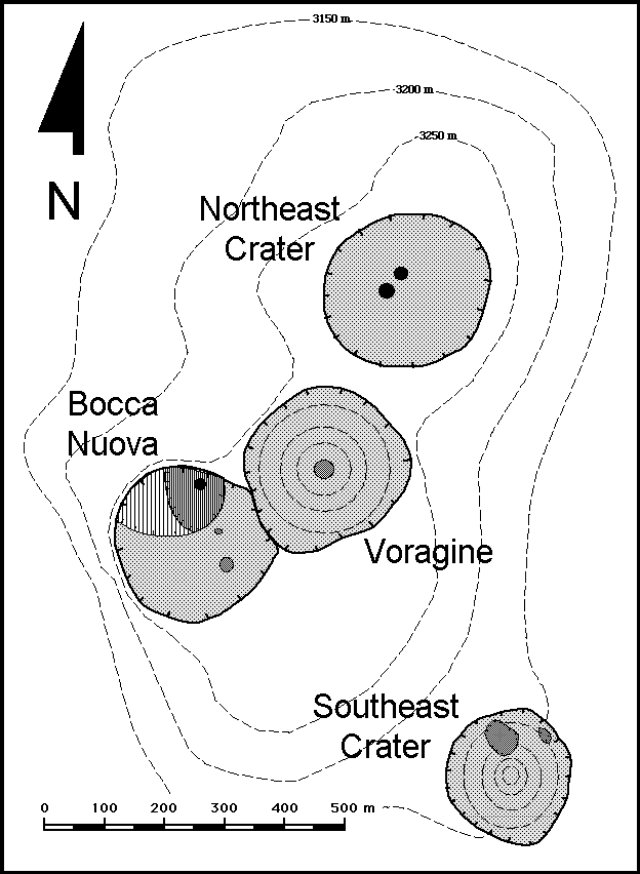Report on Etna (Italy) — September 1995
Bulletin of the Global Volcanism Network, vol. 20, no. 9 (September 1995)
Managing Editor: Richard Wunderman.
Etna (Italy) Ash emissions and another episode of Strombolian activity from the summit craters
Please cite this report as:
Global Volcanism Program, 1995. Report on Etna (Italy) (Wunderman, R., ed.). Bulletin of the Global Volcanism Network, 20:9. Smithsonian Institution. https://doi.org/10.5479/si.GVP.BGVN199509-211060
Etna
Italy
37.748°N, 14.999°E; summit elev. 3357 m
All times are local (unless otherwise noted)
A strong episode of black ash emission from Northeast Crater (figure 60) during the late morning of 13 September lasted only a few minutes, sending an ash plume 100 m above the crater rim. Red ash emissions from Bocca Nuova and Northeast Crater continued until about 20 September, but explosions of variable frequency and intensity were heard from both throughout the month. Voragine (Chasm) and Southeast Crater exhibited only weak degassing in September. Poor weather prevented internal crater observations.
On the evening of 2 October explosive Strombolian activity resumed at Northeast Crater from two small vents, aligned NNE-SSW in the lowest portion of the crater floor, ~150 m below the crater rim (figure 60). During observations the next morning, loud vigorous explosions were almost continuous, throwing scoria above the crater rim. A slight decrease in the frequency and energy of the explosions occurred that afternoon, although some incandescent bombs fell on the outer crater slope. Activity continued to decline during the night, and on the morning of 4 October Strombolian explosions were restricted to a single vent ejecting bombs up to a few tens of meters above the crater floor. By the evening of 5 October only incandescent degassing vents were present. During the same period, Bocca Nuova exhibited frequent red-brown ash emissions alternating with normal degassing. Ash emission was occasionally accompanied by incandescent bomb ejection. The ash puffs, more copious on the morning of 3 October, were produced by the same partially collapsed vent that was the site of Strombolian activity in August (BGVN 20:08).
Bombs collected on the crater rim (the first accessible material since the end of the 1991-93 eruption) were geochemically comparable with the 1991-93 lavas. The bombs were porphyritic hawaiite with phenocrysts of plagioclase (~16 volume %), clinopyroxene (~4%), olivine (~1%) and Ti-magnetite microphenocrysts in an intersertal groundmass.
Geological Summary. Mount Etna, towering above Catania on the island of Sicily, has one of the world's longest documented records of volcanism, dating back to 1500 BCE. Historical lava flows of basaltic composition cover much of the surface of this massive volcano, whose edifice is the highest and most voluminous in Italy. The Mongibello stratovolcano, truncated by several small calderas, was constructed during the late Pleistocene and Holocene over an older shield volcano. The most prominent morphological feature of Etna is the Valle del Bove, a 5 x 10 km caldera open to the east. Two styles of eruptive activity typically occur, sometimes simultaneously. Persistent explosive eruptions, sometimes with minor lava emissions, take place from one or more summit craters. Flank vents, typically with higher effusion rates, are less frequently active and originate from fissures that open progressively downward from near the summit (usually accompanied by Strombolian eruptions at the upper end). Cinder cones are commonly constructed over the vents of lower-flank lava flows. Lava flows extend to the foot of the volcano on all sides and have reached the sea over a broad area on the SE flank.
Information Contacts: Sonia Calvari and Massimo Pompilio, CNR Istituto Internazionale di Vulcanologia, Piazza Roma 2, 95123 Catania, Italy.


